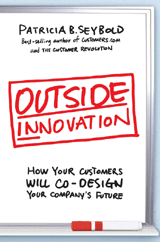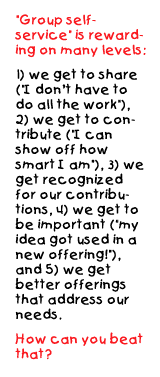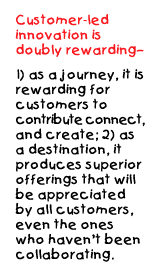An Excellent Primer for the Core Competency of the 21st Century
 To thrive in the Knowledge Economy, companies will have to learn how to innovate at warp speed, or they will simply slip beneath the surface of the water like stricken liners. Ultra low costs and exceptional quality feature sets are merely expected, and they no longer differentiate.
To thrive in the Knowledge Economy, companies will have to learn how to innovate at warp speed, or they will simply slip beneath the surface of the water like stricken liners. Ultra low costs and exceptional quality feature sets are merely expected, and they no longer differentiate.
Conventional wisdom holds that “innovation” cycles reappear every five years, when companies have exhausted the then-current cost-cutting approaches and need to focus on driving the top line.
However, the Knowledge Economy doesn’t call for your father’s innovation. The 21st century kind will require that companies turn themselves inside-out. Winners will learn to engage and catalyze their customers’ creativity. As author Patty Seybold aptly puts it, “Companies with the smartest customers win.” Outside Innovation is an in-the-trenches manual for evolving your company to embrace the innovation imperative.
Book Overview
The most difficult thing about writing this review is retaining objectivity because the book is so inspiring, insightful and infectious! Patty Seybold has been a guiding light who burst on the scene in a big way with customers.com in the late 90s (the first book of hers that I read). Her insight and commitment cut wide and deep, and you’ll be hard pressed to find a book that delivers on customer-driven innovation as well as Outside Innovation.
In the hope that an in-depth look will compel you to buy the book, I’ve provided the basic outline of each chapter as well as key takeaways. BTW, I use “case study” to denote the book’s longer practical examples and “example” for abbreviated stories. Analysis and Conclusions gives the strategic viewpoint of the importance of customer-led innovation, the book and some ramifications of key themes.
Chapter One: How to Harness Customer Innovation
Gives an overview of what outside (customer-led) innovation is, terminology and some basics about how to go about it.
- Briefly defines what customer scenarios are and how to use them to understand customer realities. How to adopt a customer outcome-focused approach to business design and how to design from the outside-in, rather than the Industrial Economy inside-out.
- Give customers important roles to play in sharing your business: lead customers (including lead users), contributors, consultants, guides and promoters, and how these customer roles work together.
- How to expand the breadth and depth of your interaction with customer-innovators.
 Chapter Two: LEGO® MINDSTORMS® NXT
Chapter Two: LEGO® MINDSTORMS® NXT
LEGO® MINDSTORMS® is widely acclaimed for its powerful example of customer-focused innovation, and this chapter takes an in-depth look into how the company turned itself around by collaborating with customers. It reflects several best practices for customer-led innovation.
- LEGO® case study
- National Instruments case study
One of the most insightful aspects of the story is how it depicts the interaction between the company and its very diverse customer groups (school kids, math teachers, professors, hackers, hobbyists). the Mindstorms product is a new category for LEGO®, which makes the world-famous interlocking plastic building blocks. Mindstorms is a programmable “brick” that can control objects that are built of LEGO®. A vital part of the offering, however, is a computer-based software program in which the customer programs the commands that will be executed by the brick and object.
- At first, the company inspired its customers by launching the Mindstorms offering.
- The offering attracted software hackers, engineers, teachers and hobbyists, who began collaborating to improve the software. They hacked some of the company’s information and processes, and the company embraced it and encouraged it.
- The interaction took off, and the book shows how the energy built to produce a blockbuster offering.
- The company and customers created online communities, global contests (who can make the most extraordinary robot).
- Extending the success with a key partnership with National Instruments, a company with virtual instrumentation offerings.
- The chapter also takes a look at the LEGO® partnership from NI’s perspective, and how it extended customer innovation it developed with LEGO® to its customers in general.
Chapter Three: Help Customers Reach Their Goals
This chapter addresses how to capture end customers’ “context” and “desired outcomes.”
- Staples case study. How the company took a deep dive into customers’ experience in stores, online and at home. They used their discovery to create differentiating value.. in a “commodity” business! An interesting aspect was how Staples took over part of the couponing process from a partner, making it work better for everyone in the process.
- Stories about using Communispace, an online community vendor, to understand customers interests and passions; Hallmark, Kraft, RC2, Schwab and Unilever examples.
- Koko® Fitness case study. The concept behind the business was customer-driven from the start. Takes you through how co-founders conceived and built their business.
- Zopa case study. A digital business that’s taking the world by storm. Puts you behind the wheel and shows how the founder followed customer pain points to create a business in which individuals lend money to other individuals—without banks.
By culling examples from a wide variety of businesses, the book shows the wide applicability of the concepts while getting your imagination going.
Chapter Four: Let Customers Strut Their Stuff
Chapter four is replete with examples of companies leveraging customer-created content. The second best chapter is worth the price of the book alone.
- Tripod as an early example. Shows how fundamental the concepts are.. and how they’ve been around for many years.
- The American Institute of Physics example. AIP has a rich community of scientists that enthusiastically create offerings.
- How to make it easy for customers to create content for other customers (Snap-on, Cisco, Amazon, IgoUgo examples). Focuses on the vital role of online tools and how they can unleash customers’ creativity.
- The world of blogs. It’s not much of an exaggeration to say that your company must be blogging if you want to have a modicum of relevance in the emerging world. Some initial pointers on getting involved. This is not a handbook on blogging; rather it shows how blogs fit into the whole picture.
- Flickr case study. How Flickr founders created a vibrant community that is its own canvas. How customers are creating a world for themselves. Some parallels with Chapter Six.
- Mash-ups’ importance. Mash-ups are reuse and packaging/integration of service-based software into Web 2.0 sites or pages. The relevance here is how you can make services available to customers who can mash them up. It’s both metaphorical and literal.
- BBC case study. The main idea is how customers can tag and manipulate BBC content. BBC proposes, “Build your stuff with our stuff.”
 Chapter Five: Promote and Leverage Open Source Development
Chapter Five: Promote and Leverage Open Source Development
Another way to look at customer-led innovation is that many things will be “open sourced.” Open source software development holds many lessons for “sourcing from the crowd” in your industry, so this chapter takes you through the similarities.
- Open source as customer-led innovation: an overview.
- Mozilla Firefox case study. Key aspect of the passion of the community, especially in marketing and promotion.
- Asterisk and Digium case study. Especially interesting in its discussion about how to hive off the “.org entity” from the “.com” business. The founder put together a phone system (as in “PBX”) that’s now open source. Digium is a company that services the software for those who want it, like Red Hat services Linux customers.
- Cohesive Financial Technologies example. Short but valuable example of open source commercial models and strategies.
- Open source biotech: the BiOS initiative. This is obvious and inspiring. Shows how the Industrial Economy mindset adds high cost that subtracts value in the current context. Open source biotech can and will be done.
- Wikipedia case study. This is well trodden ground but it’s useful to integrate some of the concepts.
This chapter is valuable in two dimensions: if you have significant exposure to or experience with open source, it will make you aware of its wide applicability in the business world. If you’ve only heard about it but are not very familiar with how it works, you get to double dip: a good overview of what makes it tick as well as how the concepts apply to customer-led innovation.
Chapter Six: Enabling Customer Co-Design
This chapter outlines some of the models, tactics and tools you can use to enable customer collaboration. It’s not the main idea of the chapter, but I looked at it as a progression of adopting a customer-focused business model:
- Launch configuration and/or DIY construction kits and workshops. Here, customers are ordering basic options of your existing offerings, using digital tools.
- Create customer design tools. Here, customers are designing new features or offerings.
- Offer open-ended design environments in which customers have control over a wide range of parameters.
As I read it through, I found myself itching for a graphic that showed the similarities of the models as well as their progression.
- Customized, build-to-order products. Very interesting examples of how customers who design offerings for themselves and/or other customers become more valuable. They constantly up-sell themselves. There is a premium for letting the customer satisfy him/herself, and it means higher margins because cost to serve goes down while amount of order goes up.
- The GE ColorXpress® case study. Shows GE Plastics’ progression into customer-designed offerings. Context is global supply chain.
- SEI Wealth Network® case study. SEI is a service (wealth management) that achieved breakthrough with a very creative approach.
- Customer Scenario® Mapping: a tool and approach to enable customer innovation. This is a brief overview to one of the Patricia Seybold Group’s consulting tools.
- National Semiconductor case study highlights how customers build on each other’s designs. How NS created tools to enable customers.
A key insight is that when you connect customers with each other, they can collaborate with each other as well as your company. They become much smarter and more experienced, very quickly. Moreover, they can create “templates” and solutions for each other, which your company can offer to other customers. Since web-based technology is pervasive, you can enable your customers to create solutions for themselves, while getting advice from your experts and other customers. Then you capture the work and enable other customers to find it. This enables the crowd to become very smart.
 Chapter Seven: Let Customers Co-Design and Promote Your Products
Chapter Seven: Let Customers Co-Design and Promote Your Products
My favorite chapter as it’s the most visionary. Here, customers not only co-design companies’ offerings; they also actively promote them. Examples show how entrepreneurs create companies with an outside-in model. The culture of each company is strong and often has a cause that is well articulated. The companies have strong communities imbued with lifestyle preferences.
- Threadless case study. A hometown Chicago favorite! Skinny Corp has created a community in which customers design apparel, vote on each other’s designs and buy each other’s designs (which have been made by Skinny). They’ve since branched off into music and other areas, showing the wide applicability of the approach.
- Muji example. My favorite part of this case study is how the Japanese housewares and apparel company (once customers have voted on customer designs, which are then vetted by the company) asks customers to pre-commit to buying the product. Then managers decide whether to produce it.
- Karmaloop case study. How the founder kept focused on the culture of the company’s customers, who serve as evangelists and marketers of the clothing lines as well as, well, customers. The convergence of art, music and culture.
- Gaming: the ultimate customer-created offerings. Fascinating look into the world of gaming and its projected impact on culture in general (*big*) due to the expectations of customers that they can design their worlds.. literally, in a virtual way ,^). Shows the fusion of creativity, collaboration and motivation and includes parallel offshore and eBay components to the ecosystem. A brief discussion of the economics of the gaming industry.
- Key points for how to adopt a customer-centric innovation model. Five steps to becoming outside-in focused as well as five pitfalls.
Analysis and Conclusions
The Riot Act
- As I’ve written extensively (among others, see How the Knowledge Economy Will Transform Markets and the Producer/Consumer Relationship and The Transformation Imperative), most markets are bifurcating into high value-add or abject commodity. Companies that survive will either have to field high value-add offerings or beat Wal-Mart.
- Innovation means delivering an offering that customers perceive as superior, and the “superior” bar keeps going up. People are willing to pay more when they are delighted. However, jaded customers are no longer fooled by half-baked product extensions that are passed off as “new!” and “innovative,” especially customers who are a smart, connected crowd. Unless your supply chain can compete with Wal-Mart’s, you will have to innovate or fade away.
- Industrial Economy companies have always been poor innovators because they’ve approached innovation in isolation from customers and, to be fair, it hasn’t been economically feasible to collaborate with customers until now, when Web technology and processes have become ubiquitous. In the Knowledge Economy, customer expectations will increase, and I will venture that you will not be able to create a sustainable innovation capability without extensive customer involvement.
- Outside Innovation makes a convincing case that collaborating with customers will be an effective way to innovate. Customer engagement will therefore be the key to thriving in the new environment. You can’t afford to overlook this book!
Group Innovation Is a Return to Our Roots
- The Industrial Economy produced—and will continue to produce—unprecedented wealth. Humankind has gained tremendously through the mechanized transformation of raw materials into useful tools and “products.” But it’s had a cost: we’ve had to sacrifice some of our humanity to accommodate “the machine” that couldn’t take into account our individual wishes in many instances.
- Administrative (“service”) processes have often been alien to us. Companies still regularly ask us to take care of them: “I’m sorry, this department can’t do that for you right now. We require three day’s notice for that kind of transaction. I hope you can understand.” We still hear it so often that we barely notice.
- The era of hamstrung legacy enterprise systems is drawing to a close (see Demystifying the Virtues of Virtualization and The Revolution in Enterprise Software). Companies are becoming more agile in the “back end,” and they will be able to retain scale while accommodating a wider range of customer wants. However, they need a vision and approach to “bring customers in” to the enterprise. Outside Innovation is an excellent start.
- Customer-led innovation will emerge as “the” core competency in the medium term. It is virtuous for two reasons that are well illustrated in the book:
- Customers enjoy collaborating to make their own experiences more rewarding, so they assign higher value to companies that enable them to satisfy themselves.
- Customer-generated content and initiatives are usually more economical than company-produced content. Think about outsourcing a large chunk of your customer-facing processes to customers. The book doesn’t make the sourcing reference because it isn’t about saving money, it’s about creating more value. BTW, the sourcing approach my clients take also emphasizes innovation over cost reduction, but that’s a different story.
- Collective self-service runs native in homo sapiens. It’s a return to our roots. We feel angst over things we can’t influence or control, and we feel, er, empowered when we can act and get results. “Group self-service” is rewarding on many levels: we get to share (“I don’t have to do all the work”), we get to contribute (“I can show off how smart I am”), we get recognized for our contributions (by each other and by the company), we get to be important (“my idea got used in a new offering!”), and we get better offerings that address our needs. How can you beat that?
- This is a completely different context than the “self-service” of the late 90s, when people began to willingly take over minor tasks they’d formerly had to delegate to companies whose obstreperous systems were too inward-focused to interact with mortals until Web interfaces emerged. That was trivial compared to our subject here, collective innovation for new offerings.
- We like to do fun things, and we will reward companies that enable us to have fun, to show off our creativity and to be generous. They make us feel good about ourselves.
- Customer-led innovation is doubly rewarding—as a journey, it is rewarding for customers to connect, contribute and create. As a destination, it produces superior offerings that will be appreciated by all customers, even the ones who haven’t been collaborating.

[…] Don’t miss my review of Patty Seybold’s excellent latest book, Outside Innovation: How Your Customers Will Co-design Your Company’s Future. […]